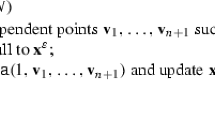Abstract
Simplicial decomposition is a special version of the Dantzig—Wolfe decomposition principle, based on Carathéodory's theorem. The associated class of algorithms has the following features and advantages: The master and the subprogram are constructed without dual variables; the methods remain therefore well-defined for non-concave objective functions, and pseudo-concavity suffices for convergence to global maxima. The subprogram produces affinely independent sets of feasible generator points defining simplices, which the master program keeps minimal by dropping redundant generator points and finding maximizers in the relative interiors of the resulting subsimplices. The use of parallel subspaces allows the direct application of any unrestricted optimization method in the master program; thus the best unconstrained procedure for any type of objective function can be used to find constrained maximizers for it.
The paper presents the theory for this class of algorithms, the APL-code of a “demonstration” method and some computational experience with Colville's test problems.
Similar content being viewed by others
References
J. Abadie and J. Carpentier, “Generalization of the Wolfe reduced gradient method to the case of nonlinear constraints”, in: R. Fletcher, ed.,Optimization (Academic Press, London, 1969). pp. 37–47.
K.J. Arrow and A.C. Enthoven, “Quasi-concave programming”,Econometrica 29, (4) (1969) 779–800.
P. Broise, P. Huard and J. Sentenac,Décomposition des programmes mathématiques, (Dunod, Paris, 1968).
A.R. Colville, “A comparative study on nonlinear programming codes”IBM Technical Report No. 320-2949, New York Scientific Center, 1968.
G.B. Dantzig,Linear programming and extensions (Princeton University Press, Princeton, NJ, 1963).
G.B. Dantzig and P. Wolfe, “Decomposition principle for linear programs”,Operations Research 8 (1) (1960).
W.C. Davidon, “Variable metric method for Minimization” Research and Development Report ANL-5900 (Ref.) U.S. Atomic Energy Commission, Argonne National Laboratories (1959).
R. Fletcher and M.J.D. Powell, “A rapidly convergent descent method for minimization”,The Computer Journal, 6 (1963) 163–168.
R. Fletcher and C.M. Reeves, “Function minimization by conjugate gradients”,The Computer Journal 7 (1964) 149–154.
M. Frank and P. Wolfe, “An algorithm for quadratic programming”,Naval Research Quarterly, 3 (1, 2) (1956) 95–109.
A.M. Geoffrion, “Elements of large-scale mathematical programming”,Management Science, 16 (16) (1970) 652–691.
C.A. Holloway, “An extension of the Frank and Wolfe method of feasible directions”,Mathematical Programming 6 (1974) 14–27.
J.E. Kelley, “The cutting-plane method for solving convex programs”Journal of the Society for Industrial and Applied Mathematics VIII (4) (1960) 703–712.
D.G. Luenberger,Introduction to linear and nonlinear programming (Addison-Wesley, Reading, MA, 1973).
O.L. Mangasarian,Nonlinear programming (McGraw-Hill, New York, 1969).
W.C. Mylander, “Finite algorithms for solving quasiconvex quadratic programs”Operations Research 20 (1) (1972) 167–173.
R.T. Rockafellar,Convex analysis (Princeton University Press, Princeton, NJ 1970).
J. Rosen, “The gradient projection method for nonlinear programming, II. Non-linear constraints”,Journal of the Society for Industrial and Applied Mathematics 9 (1961) 514–532.
H.H. Rosenbrock, “An automatic method for finding the greatest or least value of a function”,Computer Journal 3 (3) (1960) 175–184.
B. Shah, R. Buehler and O. Kempthorne, “Some algorithms for minimizing a function of several variables”,Journal of the Society for Industrial and Applied Mathematics 12 (1964) 74–92.
P. Van Moeseke, “Stochastic linear programming: A study in resource allocation under risk”,Yale Economic Essays, 5 (1965) 196–254.
B. von Hohenbalken, “Differentiable programming on polytopes”,Research Paper Series, Department of Economics, University of Alberta No. 14 (1972).
B. von Hohenbalken, “A finite algorithm to maximize certain pseudoconcave functions on polytopes”,Mathematical Programming 8 (1975) 189–206.
H.M. Wagner,Principles of operations research (Prentice-Hall, N.J., 1969).
P. Wolfe, “Methods of nonlinear programming”, in: J. Abadie, ed.,Nonlinear programming (Wiley, New York, 1967) ch. 6, pp. 97–131.
P. Wolfe, “Finding the nearest point in a polytope”,Mathematical Programming 11 (1976) 128–149.
P. Wolfe, “A method of conjugate subgradients for minimizing nondifferentiable functions”,IBM Research Journal RC 4857, Yorktown Heights, NY (1974).
W.I. Zangwill,Nonlinear programming: A unified approach (Prentice-Hall, Englewood Cliffs, NJ, 1969).
Author information
Authors and Affiliations
Additional information
I am grateful to Philip Wolfe for encouraging me to write this paper, and I am indebted to him and a referee for helpful comments.
Research was partially supported by a grant of the University of Alberta.
Rights and permissions
About this article
Cite this article
Von Hohenbalken, B. Simplicial decomposition in nonlinear programming algorithms. Mathematical Programming 13, 49–68 (1977). https://doi.org/10.1007/BF01584323
Received:
Revised:
Issue Date:
DOI: https://doi.org/10.1007/BF01584323




